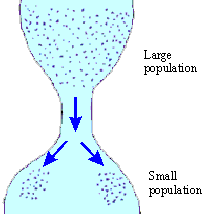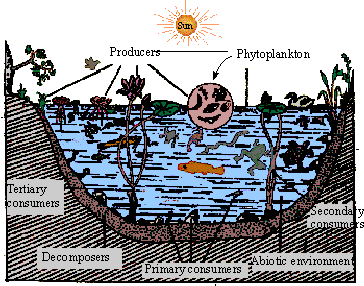Bottleneck phenomena also called genetic drift
(variations in gene frequency), play an important role in organic
evolution, like mutations and natural selection. The population
of some species may get reduced by natural calamities like floods,
droughts, epidemic, etc. A few individuals survive such critical
stages; they contain a smaller number of genes than the genetic
pool of the original population. After tight ecological conditions,
these few individuals give rise to the entire future populations.
This phenomenon of periodically squeezing through (as if
going through a narrow bottleneck) endangered or threatened conditions
by a few individuals of a species, facing tight ecological conditions
and regaining the optimum concentration of its population is called
the bottleneck phenomenon.
The bottleneck phenomenon is also seen when a few
individuals of the species stray out of their normal population
and establish a separate successful population in a new habitat.
For example, Zoroastrians like a few Parsis and Iranians who migrated
to India from Persia have now established their own population in
India.

Fig. 25.4 Bottleneck phenomenon
Community
All organisms living in a particular ecosystem
constitute a community, while the group of organisms of a single
species in an ecosystem is called population. A community is thus
a localized group of several populations. For example, a pond may
contain insects, frogs, fish and plants, together forming a biotic
community, but it is made up of different populations (e.g. frog
population, insect population, fish population, etc).
Structure of community: community contains
three fundamental groups producers, consumers and decomposers-which
are dependent on each other and maintain a dynamic, stable community
in spite of many deaths and new arrivals.
Dominant species: The species which exerts
a major controlling influence on the community because of their
size or number is called a dominant species, for example in grasslands
grazing animals like sheep, cows, horses, etc. are dominant, while
in thick forest, carnivores like lions, tigers, wolves, etc. are
dominant.
Transitional species: These are the species
which are found where two communities meet, i.e. between forest
and grassland, between freshwater and marine habitat, between deep
waters of sea and estuarine (towards the shore). These regions contain
some organisms of both the communities. Thus, it shows a greater
number of species and a higher population density, and may show
some new species which are adapted to live in that mixed region.

Figure 25.5 Communities of a pond
A complex of communities is known as a biome. It
is characterized by climatic and soil conditions. Each one is known
by the presence of distinct plants and animals.
Interdependence of plants and animal in communities
As stated above, animals depend on plants for food,
oxygen and energy, while plants depend on animals for pollination
and dispersal of fruits and seeds. Thus all living organisms are
interdependent and show "ecological kinship" for a number
of things. In other words, they always live in harmony on the principle
of "give and take" to maintain equilibrium and to establish
a stable and self regulating ecosystem. The larger communities of
both land and water show stratification and influence the effects
of climatic and other abiotic and biotic environmental factors on
the organisms.
Communities of pond : A fresh-water pond
as a whole represents a complete self-maintaining and self-regulating
system. It contains all four basic units, such as producers, primary
and secondary consumers and decomposers, knit together forming food
chains and food webs.